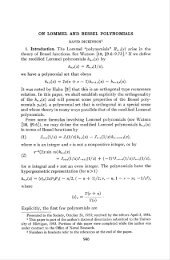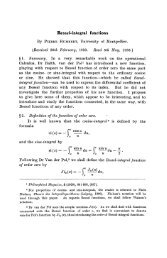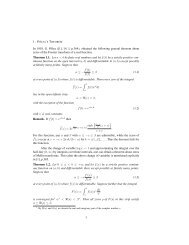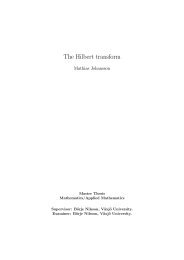C. Fox Solving integral equations by L and L(-1 ... - Fuchs-braun.com
C. Fox Solving integral equations by L and L(-1 ... - Fuchs-braun.com
C. Fox Solving integral equations by L and L(-1 ... - Fuchs-braun.com
Create successful ePaper yourself
Turn your PDF publications into a flip-book with our unique Google optimized e-Paper software.
300 CHARLES FOX [July(3) Z->[L {*(*)}] = d>(x).2. The annihilating power of L~l. Our basic result is as follows :Theorem. If(i) a>0, ¿a-|-|S>0, i>0;(ii) s = a A-ip, a <strong>and</strong> pboth real; F(s)EL(\—i, \-\- i)then(4) Z,-1 {—; f T(as + ß)F(s)r°'-i>ds\ = — f Fis)ar**-lds,\2iriJc ) 2iriJcwhere, for both <strong>integral</strong>s, the contour C may be the line a = \, a lineparallel to the imaginary axis in the <strong>com</strong>plex s plane.Proof. Let R denote the right-h<strong>and</strong> side of (4). When C is theline 0 <strong>and</strong> F(s)EL(% — i, %-\-i) that the5-<strong>integral</strong> in R, with the factor x^_1 excluded, is absolutely convergentfor all values of x.Let C be the line a = \ <strong>and</strong> consider(5) L\r\ = f e~zt {- \ F(s)xa'+»~ids\ dx.Jo \2iriJ c )The modulus of the integr<strong>and</strong> is e~xi\ F(s)|xa/s+ff_1. Hence, from theconditions, the right-h<strong>and</strong> side of (5) is an absolutely convergentdouble <strong>integral</strong>. Consequently we may change the order of integration<strong>and</strong> integrate first with respect to x. This gives us(6) L{R] = —: I T(as + ß)F(s)r°«-i>ds.2iriJ cFrom equation (3), <strong>and</strong> the remark prior to it, an application of L~lto both sides of (6) gives us(7) R = ¿-1 |—; r r(as + ß)Fis)t-—tds\ ,where Ccan be the line o = \. This <strong>com</strong>pletes the proof of (4).3. Some corollaries of (4). s-<strong>integral</strong>s <strong>and</strong> integr<strong>and</strong>s, as in (4),will be called Mellin type <strong>integral</strong>s <strong>and</strong> Mellin type integr<strong>and</strong>s.(i) (4) shows that when L~l acts on a Mellin type <strong>integral</strong> it caneliminate the factor Y(as-\-ß) from the numerator of the integr<strong>and</strong>.(ii) In (4) write F(s) =H(s)/T(asA-ß) <strong>and</strong> cancel out the <strong>com</strong>monfactor T(as-\-ß) in the left-h<strong>and</strong> side. We then see that when L~l












